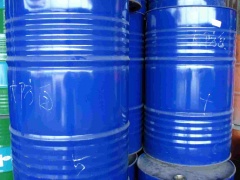Isopropanol
| Infobox on Isopropanol | |
|---|---|
| Example of Isopropanol |  |
| Facts | |
| Origin | - |
| Stowage factor (in m3/t) | - |
| Humidity / moisture | - |
| Ventilation | - |
| Risk factors | See text |
Isopropanol
Description / Application
Isopropyl alcohol (also propan-2-ol, 2-propanol or the abbreviation IPA) is a common name for a chemical compound with the molecular formula C3H8O. It is a colourless, flammable chemical compound with a strong odour. It is the simplest example of a secondary alcohol, where the alcohol carbon is attached to two other carbons sometimes shown as (CH3)2CHOH. It is a structural isomer of propanol.
Isopropyl alcohol is miscible in water, alcohol, ether and chloroform. It will dissolve ethyl cellulose, polyvinyl butyral, many oils, alkaloids, gums and natural resins. It is insoluble in salt solutions. Unlike ethanol or methanol, isopropyl alcohol can be separated from aqueous solutions by adding a salt such as sodium chloride, sodium sulfate, or any of several other inorganic salts, since the alcohol is much less soluble in saline solutions than in salt-free water. The process is colloquially called salting out, and causes concentrated isopropyl alcohol to separate into a distinct layer.
Isopropyl alcohol forms an azeotrope with water, which gives a boiling point of 80.37° C and a composition of 87.7 wt% (91 vol%) isopropyl alcohol. Water-isopropyl alcohol mixtures have depressed melting points. It has a slightly bitter taste, and is not safe to drink.
Isopropyl alcohol becomes increasingly viscous with decreasing temperature. At temperatures below -70 °C Isopropyl alcohol resembles maple syrup in viscosity.
Derivation; by treatment of propylene with sulfuric acid and hydrolyzing.
Use; manufacture of acetone and its derivatives, manufacture of glycerol and isopropyl acetate, solvent for essential and other oils, alkaloids, gums, resins, etc.; latent solvent for cellulose derivatives, coatings solvent, deicing agent for liquid fuels, lacquers, extraction processes, dehydrating agent, preservative, lotions, denaturant.
Shipment / Storage / Risk factors
Flammable, dangerous fire risk, explosive limits in air 2-12%. Toxic by ingestion and inhalation. TLV: 400 ppm in air.
Isopropyl alcohol vapour is denser than air and is flammable with a combustible range between 2 and 12.7% in air. It should be kept away from heat and open flame. Isopropyl alcohol has also been reported to form peroxides, which may explode upon concentration. Isopropyl alcohol is a skin irritant.
Melting point: −89°C
Boiling point: 82.5°C
For overseas carriage aspects of Chemicals, the readers are recommended to acquire or have access to a good chemical dictionary, and a copy of the International Maritime Dangerous Goods (IMDG) Code, issued by the International Maritime Organisation. Also consult the applicable MSDS sheet.











